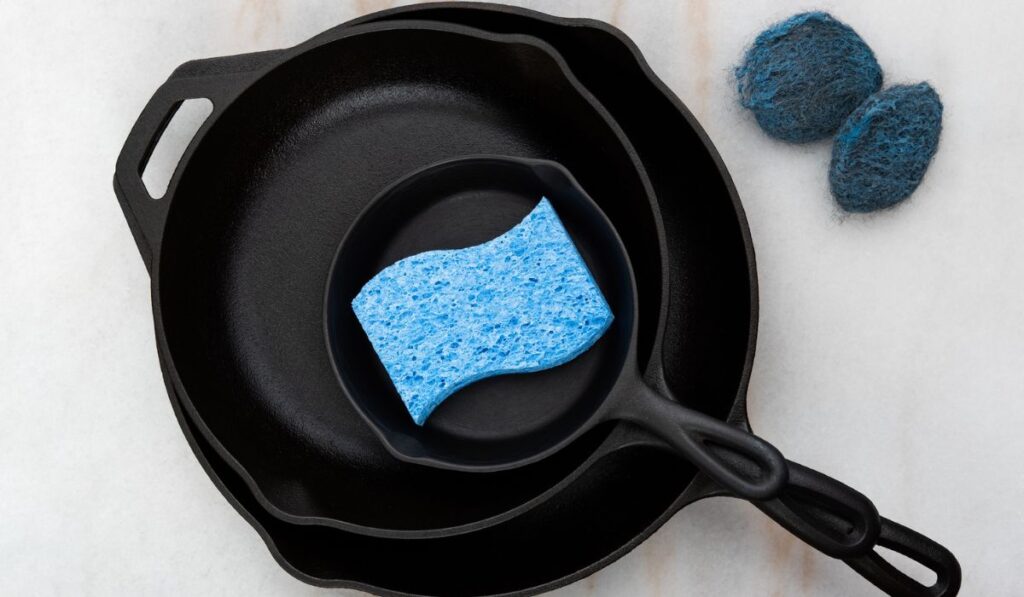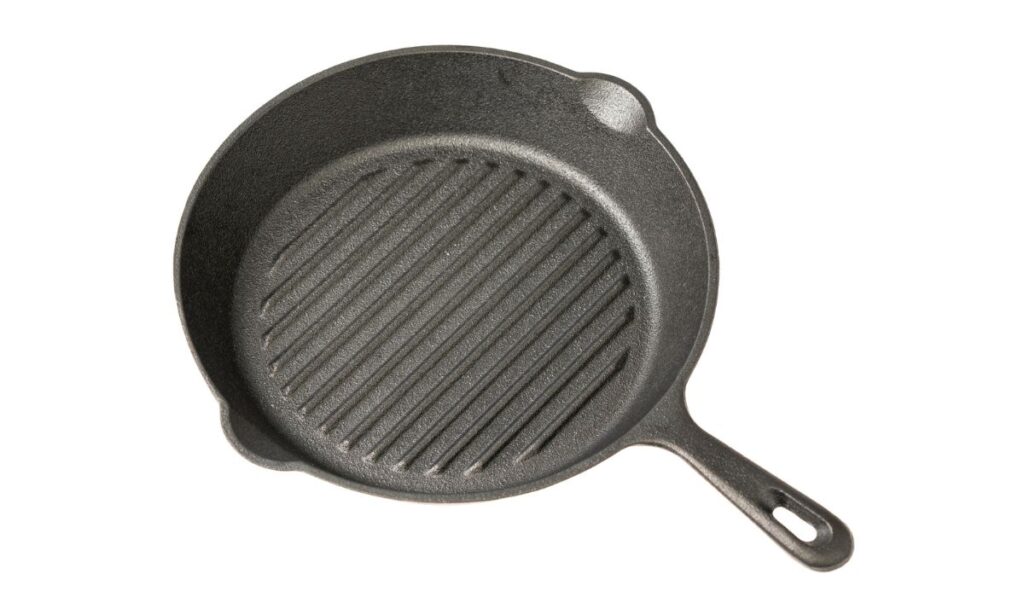For good reasons, cast iron skillets have become very popular. They are easy to use and can last a lifetime because they are cast iron. However, when you want your skillet to last longer, you must maintain it well. One way of doing so is by cleaning it well.
A cast-iron skillet may only need wiping with a dry paper towel after use. But if the food sticks or there’s rust, wash it. Hot water may suffice, but if the debris fails to come off, use mild soap or steel wool. Then dry and season it before storing it.
A skillet is an excellent addition to your kitchen because you can use it for cooking almost all the foods that need a pan. So please read on to find out why you need to clean your skillet and how to wash it, season it, and store it.
Is it Good to Wash a Cast-Iron Skillet?

Whether you buy a new or used cast iron skillet, there are a few things you need to know about these cooking pans. First, cast iron skillets need different care than pans made of other materials. You have to wash your skillet before you use it.
In the case of a new skillet, the washing process will be different because you’ll have to use hot, soapy water. Maybe someone has told you never to use soap on a new cast iron skillet, but that isn’t true.
When handling a new skillet, soap is good. Washing is a new skill that removes rust bits and factory chemicals. Make sure you rinse the skillet well after washing it.
Do You Need Water to Wash a Cast Iron Skillet?
The question remains whether you need to wash your cast iron skillet after using it. Whether to wash the skillet depends on what you’ve cooked in it.
For example, if you made grilled cheese, the skillet may not need to be washed. All it may need is for you to use a dry paper towel to wipe it clean, then reseal it with some oil and swirl it again with the same towel.
On the other hand, if you’ve prepared a sauce that has messed up the skillet, the best way to clean it is to wash it. You can fill it with water, heat it over a stove until it boils, then pour it out.
Allow the skillet to cool, scrub it with soft nylon, and reseal. Never use soap, a harsh detergent, or steel wool to clean your cast iron skillet.
Cast Iron Skillet Cleaning
It’s advisable to clean your cast-iron skillet immediately after use. Remember not to soak or leave it in sink water because it can rust. So you’ll need:
- A stiff brush or sponge
- Paper towels or clean, dry clothes
- Shortening or vegetable oil
- Stove (optional)
- Kosher salt (optional)
How to Clean a Cast Iron Skillet
To clean this type of skillet, you will need to:
- Boil some water on the stove, then add it to the skillet. Wear gloves or use tongs when cleaning the skillet to protect your hands against the hot water.
- Use a stiff brush or sponge to clean the skillet. Never use steel wool, detergent, or dishwasher soap because they may strip the pan of its seasoning.
- If there are any stuck-on bits, scrub them using a paste of kosher salt and water, then wipe with a paper towel or rinse with water. You can also use more boiled water to loosen any stubborn food residue in the skillet.
- Dry the skillet thoroughly. You can either dry it on the stove using low heat or use a clean, dry paper towel to dry it.
- Oil the skillet. Dab a clean paper towel in shortening or vegetable oil, then apply the oil to the skillet’s surface. If you wish, you can also use the oil on the outer surface of the skillet.
- Remember to wipe off any excess oil. The oil protects the pan against moisture that can cause rusting.
- Keep the skillet in a dry place.
Note: If you’ve used your cast iron skillet for years and it’s well seasoned, using a mild cleaning soap won’t cause any damage. Likewise, you can use steel wool to remove rust from the pan, but once you do that, you need to re-season the pan.
How to Season a Cast Iron Skillet
Whether you have a brand new skillet or one you’ve already used, seasoning or re-seasoning is necessary before using it. Before seasoning, make sure the pan is clean and rust-free.
You can use shortening or vegetable oil to season your pan. Apply a thin coat of oil on the pan’s surface, inside and outside, including the handle. Put the skillet upside down in an oven and bake it for one hour at 350 degrees Celsius.
You can place some aluminum foil on the lower rack of the oven to catch any dripping oil. Then, leave the skillet in the oven to cool. Once it’s cold, it’ll be ready for use.
When to Get a New Cast Iron Skillet

Even though cast iron products are considered indestructible, eventually, they will wear down and need replacement. Cast iron skillets aren’t an exception. You’ll know your skillet needs a replacement when you observe the following:
The Base Becomes Wobbly
To test whether the base of your pan is wobbly, place it on a burner and allow it to heat for some time. Then, press down on its handle and observe it. If it wobbles, it means the base is warped. Severe wobbling results in an uneven distribution of heat, meaning your food won’t cook evenly if you use it.
A Crack
As you use the pan, it will undergo a series of expansions and contractions, which will increase the size of the crack, and eventually, the pan will split.
If you see any pan cracks, it’s time to replace it. It doesn’t matter the size of the crack, even if it’s a hairline crack. Cracks are difficult to clean and provide a conducive environment for rusting and bacterial growth.
A Hole
Just like a crack, a pan with a hole should never be used for cooking. Likewise, a hole in a skillet signifies that it is damaged and needs replacement.
Rust
One of the most severe disadvantages of cast-iron skillets is that they rust. If you don’t store it in a moist environment, you’ll see it turn brown. Slight rusting may not be an issue because you can clean it off, as already explained. However, if the rusting is severe, you may be forced to replace the pan.
Rust isn’t healthy when it finds its way into your food. Rust also damages the pan because it can lead to the formation of cracks and holes. To avoid rusting, ensure your pan is dried, seasoned, and stored in a dry place.
Cast Iron Skillet Care Instructions
When taken good care of, a cast-iron skillet can be passed from generation to generation. To make your pan last longer, observe the following:
- Use gentle utensils like rubber, silicone, or wood with your skillet.
- Be cautious when cooking acidic foods like bananas, citrus, or tomatoes. The acid can strip the seasoning off, leading to food discoloration and a metallic taste. Make sure the pan is well seasoned before cooking acidic foods.
- Don’t store foods in the pan, as this can encourage rusting.
- Heat the pan slowly and don’t use a very high temperature, which encourages food sticking.
- Avoid soaking the pan to avoid rusting; clean it the right way.
- Store it when it’s clean, dry, and seasoned. The place where you store it must also be dry.
- Stack the pan carefully when storing it. And place a paper towel between it and the other cookware to protect it.
